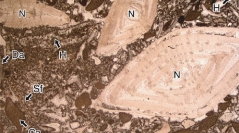

 Geodiversitas
34 (1) - Pages 189-217
Geodiversitas
34 (1) - Pages 189-217The lithology of Cretaceous to Pleistocene shallow-water carbonates, which were collected from 29 sites on 24 submerged seamounts in the northwestern Pacific Ocean using the Deep-sea Boring Machine System, are described. The shallow-water carbonate deposits examined in the present study can be roughly divided into three types based on their composition: Cretaceous, Eocene (to lowest Oligocene?), and Oligocene to Pleistocene. The Cretaceous type is characterized by an abundance of molluscs (including rudists), smaller foraminifers, microencrusters, non-skeletal grains (e.g., peloids, cortoids, and intraclasts), and microbial sediments. Most components have been micritized and possess thick micrite envelopes. The Eocene type is characterized by the dominance of larger foraminifers, Halimeda spp., nongeniculate and geniculate coralline algae, bryozoans, and dasycladacean algae. Scleractinian corals are very minor components. The Oligocene to Pleistocene type is similar in composition to the Eocene type, but it differs from the latter by the abundant occurrence of scleractinian corals and nongeniculate coralline algae. Corals, nongeniculate coralline algae, and Halimeda spp., which precipitate carbonates within closed to semi-closed spaces in and around their bodies (intra-tissue), are major components of the Eocene and Oligocene to Pleistocene types. In contrast, the Cretaceous-type sediments contain relatively more carbonates of extra-tissue origin (i.e. carbonates deposited in relatively open spaces around the bodies of organisms, such as rudists, as well as microbialite and ooids) than the Eocene and Oligocene to Pleistocene types. The changes in the major constituents of the carbonate factory depend on local environments, such as nutrient availability, as well as a global factor: seawater chemistry in the surface waters. Temporal variations in the abundance of the shallow-water carbonates on the examined seamounts suggest that carbonate accumulation was not necessarily controlled by climatic conditions; instead, it was related to the volcanism and tectonics that served as the foundations for reef/carbonate-platform formation.
shallow-water carbonate, seamount, northwestern Pacific Ocean, seawater chemistry, Late Cretaceous, Cenozoic